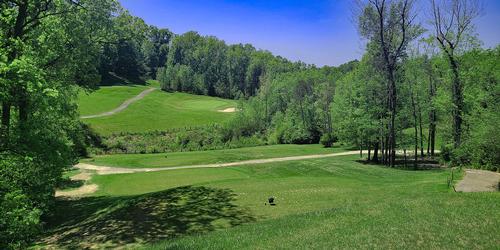
The Cullan at Mineral Mound: Gem of the Kentucky State Parks
By Kiel Christianson
Long before the land on the shores of Lake Barkley, Kentucky, was a golf course - or even before it was a state park - it was the family farm of Willis B. Machen, grandfather of Zelda Sayre Fitzgerald. The tempestuous Zelda was a celebrated writer and the wife of author F. Scott Fitzgerald. One of my favorite F. Scott Fitzgerald stories is The Diamond as Big as The Ritz. Although that story is set in Montana (and is actually extremely dark), I couldn't help but think about it as I played The Cullan at Mineral Mound State Park: the golf course is a real gem, and since it is a golf course, it is technically bigger than The Ritz-Carleton Hotel.
The Kentucky State Parks system consists of over 45 parks, with a dozen golf courses sprinkled throughout the parks across the state. The Cullan is one of the newest and was designed by renowned golf course architects Dr. Michael Hurdzan and Dana Fry (who also designed Erin Hills, site of the 2017 U.S. Open and 2025 U.S. Women's Open).
The par-72 layout measures 6,561 yards from the back tees, up to 4,411 yards from the most forward tees. The 600-yard gap between 1 Tees and 2 Tees is a bit large, making the decision about where to play tricky. Because the course is hewn out of dense hardwood forests, and several holes on the front side include carries over the waters of Lake Barkley, there are a fair number of "target golf" holes, along with plentiful blind landing areas. The best advice, then, is for even longer hitters to play the 5,964-yard 2 Tees. In the words of the starter, "Big and strong is not your friend here. Leave your driver in the bag on a lot of holes. Just find that 150-yard marker and hit the club that will get you there."
Although it is very true that precision is more important here than power, this advice doesn't hold for every hole - prudent use of the long-ball will serve players well, as long as the ball stays in play (which is easier said than done).
Playing The Cullan at Mineral Mound
I'm going to be brutally honest here: I shot my worst score in two years on The Cullan. This is a course where local knowledge REALLY pays off. As mentioned, there are blind landing areas off the tee, blind landing areas for second shots on par 5s, blind approaches to greens, blind hazards. Toss in the blinding rainstorm we finished our round in, and it felt like about a dozen more rounds would've been needed before the scales could fall from my eyes.
Despite the advice above that power isn't paramount here, the opening nine actually do demand some muscle. Hole 1 is a short par 5, but there is a rocky ditch cutting across the fairway, so if you lay too far back off the tee, the ditch becomes an issue on your second. Holes 2, 4, and 5 likewise require some controlled strength. All are cape holes, with elevated tees, carries across water or valleys, and fairways angled from right to left about 90-degrees from the teeing grounds. So long draws off the tee will put you in great position-flare your tee shots to the right, or hit them dead straight, and you'll end up in fairway bunkers or woods; don't take enough club, and you'll be wet.
The advice to find the 150-yard marker also misleads at the short par-4 18th. I followed the advice, hitting a hybrid basically next to the 150-yard marker. When I arrived at my ball, I realized the 90-degree dogleg right required a tee shot 40 yards past the 150-yard stake just to see the green. Again, local knowledge is critical here.
The 452-yard, par-4 17th Hole is the longest par 4 on the course, but it is literally the first comfortable driving hole for first-timers. There's finally enough room to feel like you can freely swing your driver, rather than aiming it.
Despite the difficulty of play associated with such a hilly, woodsy, target-y design, the land and waters of Lake Barkley are quite lovely. The Bermuda fairways and bentgrass greens were in good early-season shape, and the white-sand bunkers were well maintained. And several holes are truly memorable.
The aforementioned Hole 2 is just 306 yards from the tips, but a strong, controlled draw will get you around the trees to the blind landing area just short of the green. As noted though, a big straight ball will sail over those bunkers across the fairway.
The 389-yard, par-4 5th is another cape hole where a powerful draw really helps. Blind tee shots even continue at the downhill par-3 7th, where the green might be occluded by the end of the tee elevated tee box, depending on which tees you play.
The par-5 13th consists of one blind shot after another. My layup over a hill to what I thought was the center of the fairway, apparently found a steep hillside and ran into the woods. The longest of the par 5s, this triple-dogleg is practically unplayable on your first visit here - you simply can't tell where to aim from tee to green.
The par-3 16th plays over water to a wide, shallow green, capping off a nice, varied collection of one-shotters. And again, the long 17th is really the first and only tee shot where newbies are likely to feel comfortable, because even though the fairway is lined on both sides by thick woods, it is wider than the other fairways on the course-you'll probably even see your ball land!
The Cullan at Mineral Mound State Park: The Verdict
The Cullan is a scenic course that demands control off the tee. Length will be rewarded, but selectively. Greens are often elevated, and going long at most of them usually results in a lost ball. This layout was carved out of the state park forest, and most holes are isolated from their neighbors, with long drives between greens and tees. Given these distances and the extremely hilly topography, it is not walkable, unfortunately. Because familiarity with the course will undoubtedly help scoring, I would recommend booking two rounds here - you'll probably enjoy your second one much more (and lose far fewer balls!). If you want to play more, or are looking for nearby alternatives, I recommend Kentucky Dam Village State Park Golf Course in Calvert City (about 30 min. away). This course was laid out by the legendary golf course architect Perry Maxwell, and it requires considerably less local knowledge, as most of the holes are right in front of you. The cabins at Kentucky Dam Village are comfortable and affordable, too.
Finally, a word about the course's moniker, "The Cullan." The course at Mineral Mound was renamed posthumously after Cullan Brown, who had a distinguished amateur career nationally, internationally, and at the University of Kentucky. A posthumous inductee into the Kentucky Golf Hall of Fame, Cullan grew up playing at Mineral Mound. As his playing career was really taking off, he was diagnosed with cancer in his leg, and he died shortly thereafter. By all accounts, the young man was not only a fantastic player, but also a fantastic person, with a heart as big as The Ritz.
Revised: 08/11/2025 - Article Viewed 1,458 Times
- View Course Profile
About: Kiel Christianson
 I’ve been a travel and golf writer for online and print publications for 25 years, including over 10 years with The Golf Channel. My blog on The Golf Channel websites began in 2003, making it one of the first in the golf world. Other publications include poetry, food and travel features, and research articles in the broad area of cognitive science.
I’ve been a travel and golf writer for online and print publications for 25 years, including over 10 years with The Golf Channel. My blog on The Golf Channel websites began in 2003, making it one of the first in the golf world. Other publications include poetry, food and travel features, and research articles in the broad area of cognitive science.
Follow Kiel Christianson:
Contact Kiel Christianson:
Midwestern Golf - Publisher
217-714-4561















